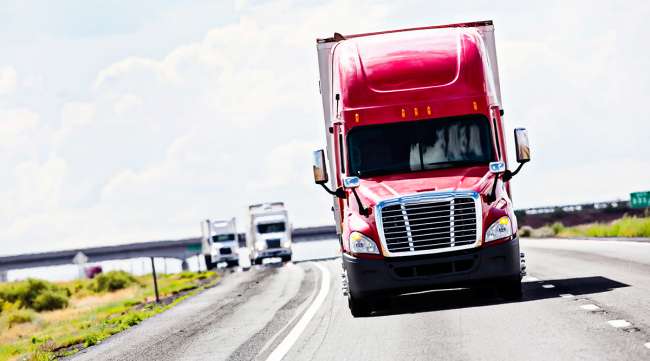Senior Reporter
Q2 GDP Drops a Record 32.9%, but Trucking Holding Steady

[Stay on top of transportation news: Get TTNews in your inbox.]
The gross domestic product of the United States shrank a record-setting 32.9% in the second quarter, tracking closely with economists’ expectations of how the COVID-19 outbreak would impact the nation’s economy during the tough early months of the pandemic.
The steep drop is the largest on record since the federal government began tabulating the numbers in 1947. The Q2 2020 figures were by the released Bureau of Economic Analysis on July 30. Analysts polled by MarketWatch were expecting a 35% decline in the GDP, which is the main gauge of the overall health of the economy.
“They’re in line in what we expected, and they’re bad,” American Trucking Associations Chief Economist Bob Costello told Transport Topics. “You can’t sugarcoat it. It was terrible. Even though it’s a quarterly number, I think June was better. I wouldn’t be surprised if the recession actually ended in June, or late May.”

Costello
However, Costello and other economists are worried that as coronavirus cases continue to increase in several highly populated states, including California, Texas, Florida, Georgia and Arizona, the progress the economy was making will stall.
“I am getting concerned we are losing momentum here in the third quarter. If unemployment claims continue to go up, there is foot traffic data that suggests that foot traffic is falling as the virus surges. We are hearing from other sectors that businesses are closing permanently,” he said. “You cannot have a full economic recovery until we have a medical solution.”
Simultaneously, as the GDP numbers were released, the Labor Department also reported initial unemployment claims reached 1.43 million. It’s the second straight week that the number has risen, and the 19th week in a row that the U.S. has seen more than a million claims for benefits.
Also, new claims from the Pandemic Unemployment Assistance program, the government program covering independent contractors, freelance workers and self-employed people, such as truck drivers and others not covered by traditional unemployment benefits, totaled 830,000, down from 975,000 the week before. Those numbers, unlike the figures for state claims, are not seasonally adjusted.

Transport Topics introduces its newest digital interview series, Newsmakers, aimed at helping leaders in trucking and freight transportation navigate turbulent times. Audience members will gain access to the industry's leading expert in their particular field and the thoughtful moderation of a Transport Topics journalist. Our second episode — "The Evolution of Electric Trucks" — featured Nikola founder and executive chairman Trevor Milton. To view the replay, complete this form.
Costello noted that much of the damage done to the economy was in the service sector, which includes hotels, restaurants and bars. Spending in the service sector dropped 43.5% in the second quarter. At the same time, he said that spending on goods including groceries and so-called big-ticket items such as appliances and exercise equipment — along with other types of online spending — declined 11.3%. Costello noted that during the spring, many trucking companies shifted to goods-focused businesses to keep freight at a decent level. At the moment, the trucking industry overall is holding its own, he said.
“The June trucking activity report numbers are good in terms of volume. All things considered, we are doing not too bad,” he said. “I think there is this initial restocking going on, and there is a surge of activity. Trucking didn’t get hit too hard.”
Confirming Costello’s analysis, DAT Freight and Analytics said its June Truckload Volume Index, which is a measure of dry van, refrigerated and flatbed loads moved by trucking companies, increased 9.4% from June 2019 and 13.7% from May.
The GDP news came as congressional and White House negotiators continued work on another COVID-19 stimulus bill that would provide financial assistance to individuals and businesses affected by the pandemic.

Dhawan
Rajeev Dhawan, the director of the Economic Forecasting Center at Georgia State University, told TT the earlier multitrillion dollar stimulus bills federal leaders advanced kept the economy from sliding into a deeper recession. However, many of the program’s benefits, including an additional $600 a week in supplemental unemployment assistance, were set to expire at the end of July. Negotiations continued as that deadline neared, but White House officials were not optimistic an agreement could be reached in time to prevent a temporary delay in checks. Republicans are proposing the current unemployment supplement be replaced with a lower $200 weekly payment. White House Chief of Staff Mark Meadows told reporters on July 29, “We’re nowhere close to a deal.”
Dhawan believes an extension of the package is needed, at least in the short term, to keep the economy moving while the scientific community works on a medical solution to the virus.
“On the consumption side, you can see the spending — basic spending — was kept afloat because of those unemployment checks that went out and kept people on the payrolls at the small businesses,” Dhawan said. “Now the issue is going forward. We can see clearly ... as the virus resurfaced, people pulled back on spending.”
Want more news? Listen to today's daily briefing:
Subscribe: Apple Podcasts | Spotify | Amazon Alexa | Google Assistant | More




